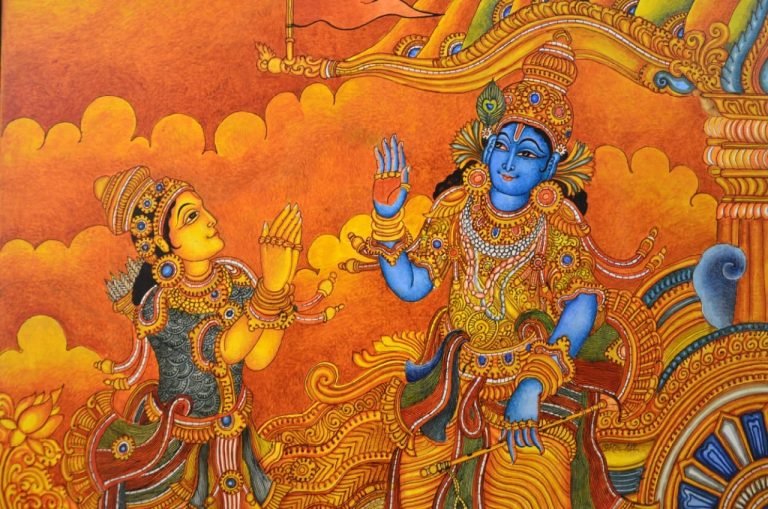I can’t show you proof of the eternal soul, other than to say that consciousness is the symptom of this eternal soul. Other than that, all I can do is allude to my source of reference for my position regarding the existence of my eternal spirit soul.

If I want to know who my father is, the best option is usually to ask my mother. In the same way, the Vedas, or books of knowledge from ancient India, can be compared to the mother, and she is informing us about our original father. This is how it is described. I have no evidence of the veracity of the statements in the Vedas regarding god, consciousness and everything in between. All I can do is point to the Vedas as a source of reference left by thinkers wiser than myself on the topics of deepest interest.
This Veda, composed in the Sanskrit language some thousands of years ago, opinions on exact dates differ, is a vast and complex body of literature. It is perhaps the biggest body of ancient literature known to the world today. They can be divided up as follows:
Division of Vedas:
1Sruti – (revealed/heard) 4 Vedas, brahmanas, aranyakas, upanishads
2smriti – (remembered tradition) Itihasas (epics) Ramayana, Mahabharata, Puranas (18 prominent mahapuranas)
6 sattvic – Vishnu, Naradiya, Bhagavat, Garuda, Padma,Varaha
6 Rajasic – Brahma, Brahmanda, Brahma-vaivartha, Markandeya, Bhavisya, Vamana
6 tamasic – Matsya, kurma, linga, Siva, Skanda, Agni
3sutras – (aphorisms) incl Vedanta-sutra
4others – vedanga, upaveda, commentaries of the acharyas
This vastly out paces any other religious or sacred literature from any other culture on the planet. The detail of history as well as detail of the mystical sciences is fascinating and leaves other literary works on god and consciousness looking like child’s play compared to this epic literature. That’s why I focus upon it, rather than the smaller and less philosophical alternatives from the cultures outside of ancient India, or Bharata.
And in the Bhagavad Gita, which is part of the Mahabharata, there is information regarding our source, or original father, as well as our true nature as consciousness. Despite no material evidence for any soul inhabiting the human body, still that human body – which is no more than a lump of inanimate matter – somehow displays developed consciousness and life. What animated the otherwise dead matter of our carbon based form to be alive? That is called by the Gita “jivatma” or spirit soul. Otherwise there is no difference between a living body and a dead body, other than consciousness.
The Gita describes the soul as invisible, very small and unchangeable, among other qualities listed in the verse quoted below. And since I can’t see it, I ask higher authority on the subject about it. I inquire into the Vedas for my answers, because these Vedic texts have all the information on matter versus spirit, as well as man and god. I’ll rather ask the experts, and my research has found no better expert than Vedanta. Please tell me if you have something more detailed or valuable regarding these subjects and I will be happy to listen.
Until then, I will listen to mother Veda about the nature of my original father, the original supreme personality of godhead, as well as my relationship with him. For a start, the Vedas describe the individual soul as minute or very small, while simultaneously describing the original godhead as vast and all-pervading. Therefore the difference between the two is massive and thus the individual soul can never even begin to compare themselves with the original source directly. Such fantasy is a sign of misguided and deluded speculation with no philosophical or logical foundation, according to the Vedas, like Bhagavad Gita ch2:25, quoted below for your information.
अव्यक्तोऽयमचिन्त्योऽयमविकार्योऽयमुच्यते ।
तस्मादेवं विदित्वैनं नानुशोचितुमर्हसि ॥ २५ ॥
avyakto ’yam acintyo ’yam
avikāryo ’yam ucyate
tasmād evaṁ viditvainaṁ
nānuśocitum arhasi
avyaktaḥ—invisible; ayam—this soul; acintyaḥ—inconceivable; ayam—this soul; avikāryaḥ—unchangeable; ayam—this soul; ucyate—is said; tasmāt—therefore; evam—like this; viditvā—knowing it well; enam—this soul; na—do not; anuśocitum—may lament over; arhasi—you deserve
TRANSLATION
It is said that the soul is invisible, inconceivable, immutable, and unchangeable. Knowing this, you should not grieve for the body.
COMMENTARY
As described previously, the magnitude of the soul is so small for our material calculation that he cannot be seen even by the most powerful microscope; therefore, he is invisible. As far as the soul's existence is concerned, no one can establish his existence experimentally beyond the proof of śruti or Vedic wisdom. We have to accept this truth, because there is no other source of understanding the existence of the soul, although it is a fact by perception. There are many things we have to accept solely on grounds of superior authority. No one can deny the existence of his father, based upon the authority of his mother. There is no other source of understanding the identity of the father except by the authority of the mother. Similarly, there is no other source of understanding the soul except by studying the Vedas. In other words, the soul is inconceivable by human experimental knowledge. The soul is consciousness and conscious—that also is the statement of the Vedas, and we have to accept that. Unlike the bodily changes, there is no change in the soul. As eternally unchangeable, the soul remains atomic in comparison to the infinite Supreme Soul. The Supreme Soul is infinite, and the atomic soul is infinitesimal. Therefore, the infinitesimal soul, being unchangeable, can never become equal to the infinite soul, or the Supreme Personality of Godhead. This concept is repeated in the Vedas in different ways just to confirm the stability of the conception of the soul. Repetition of something is necessary in order that we understand the matter thoroughly without error.
Reference: www.prabhupadabooks.com
Image: www.indusscrolls.com
